
Blackpool is a seaside resort town in Lancashire, England. It is located on the Irish Sea coast of the Fylde peninsula, approximately 27 miles (43 km) north of Liverpool and 14 miles (23 km) west of Preston. It is the main settlement in the borough of the same name. The population of Blackpool at the 2021 census was 141,000, a decrease of 1,100 in ten years.

Blackpool Tower is a tourist attraction in Blackpool, Lancashire, England, which was opened to the public on 14 May 1894. When it opened, Blackpool Tower was the tallest man made structure in the British Empire. Inspired by the Eiffel Tower in Paris, it is 518 feet tall and is the 125th-tallest freestanding tower in the world. Blackpool Tower is also the common name for the Tower Buildings, an entertainment complex in a red-brick three-storey block that comprises the tower, Tower Circus, the Tower Ballroom, and roof gardens, which was designated a Grade I listed building in 1973.

Francis Matcham was an English architect who specialised in the design of theatres and music halls. He worked extensively in London, predominantly under Moss Empires for whom he designed the Hippodrome in 1900, Hackney Empire (1901), Coliseum (1903) and Palladium (1910). His last major commission before retirement was the Victoria Palace (1911) for the variety magnate Alfred Butt. During his 40-year career, Matcham was responsible for the design and construction of over 90 theatres and the redesign and refurbishment of a further 80 throughout the United Kingdom.

The Lyceum is a 1,068-seat theatre in the City of Sheffield, England.

The Rex is a cinema in the town of Berkhamsted, Hertfordshire, England. Designed in the art deco style by David Evelyn Nye in 1936, the cinema opened to the public in 1938. After 50 years of service, the cinema closed in 1988 and became derelict. The building was listed Grade II by English Heritage, and following a campaign to save the Rex by a local entrepreneur, the cinema re-opened to the public in 2004.
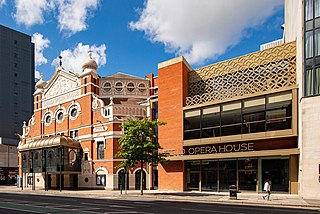
The Grand Opera House is a theatre in Belfast, Northern Ireland, designed by the most prolific theatre architect of the period, Frank Matcham. It opened on 23 December 1895. According to the Theatres Trust, the "magnificent auditorium is probably the best surviving example in the United Kingdom of the oriental style applied to theatre architecture". The auditorium was restored to its former glory, and the foyer spaces and bars were reimagined and developed as part of a £12.2 million project in 2020/2021, generously supported by the National Lottery Heritage Fund. [1]

The Grand Theatre in Lancaster, England is one of the oldest theatres in England and the third oldest in Britain, having been in near continuous use since 1782. Though it has seen numerous extensions and alterations, much of the original stone has survived. The theatre is recorded in the National Heritage List for England as a designated Grade II listed building.

The King's Theatre is located in Glasgow, Scotland. It was built for Howard & Wyndham Ltd under its chairman Baillie Michael Simons as a sister theatre of their Theatre Royal in the city and was designed by Frank Matcham, opening in 1904. The theatre is primarily a receiving house for touring musicals, dance, comedy and circus-type performances. The theatre also provides a prominent stage for local amateur productions. The King's Theatre also stages an annual pantomime, produced by First Family Entertainment. The theatre is currently operated by the Ambassador Theatre Group, under a lease from Glasgow City Council who own the building.
William Robert 'Bertie' Crewe was one of the leading English theatre architects in the boom of 1885 to 1915.
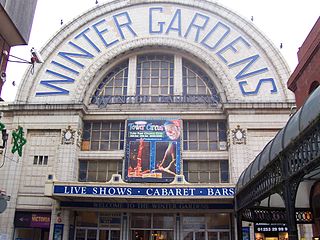
The Winter Gardens is a large entertainment complex in Blackpool, Lancashire, England, which includes a theatre, ballroom and conference facilities. Opened in 1878, it is a Grade II* listed building, operated by Blackpool Entertainment Company Limited on behalf of Blackpool Council, which purchased the property from Leisure Parcs Ltd as part of a £40 million deal in 2010.
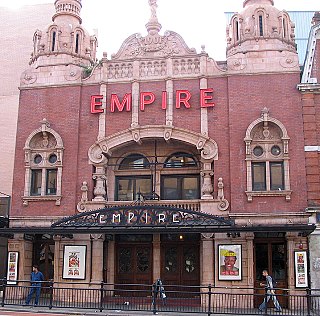
Hackney Empire is a theatre on Mare Street, in Hackney in the London Borough of Hackney. Originally designed by Frank Matcham it was built in 1901 as a music hall, and expanded in 2001. Described by The Guardian as "the most beautiful theatre in London" it is an Arts Council England National Portfolio Organisation.
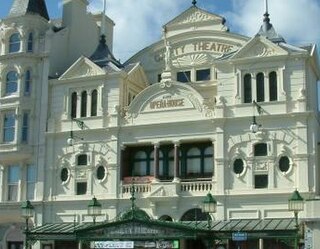
The Gaiety Theatre and Opera House is a theatre in Douglas, Isle of Man which together with the Villa Marina forms the VillaGaiety complex. The Gaiety is situated on Douglas promenade, overlooking the sea and adjacent to the Villa Gardens, Arcade and Butts.

The Theatre Royal Wakefield is a theatre in Wakefield, England, which dates back to 1894. The theatre was originally known as the Theatre Royal and Opera House and dates back to the 1770s.
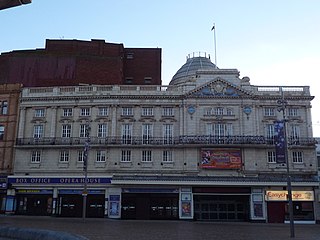
The Opera House Theatre is a theatre in Blackpool, Lancashire, England. It is located within the Winter Gardens, a large entertainment complex in the town centre and originally opened in 1889, although it has been rebuilt twice, in 1910 and 1939.

Everyman Theatre is a theatre based in Regent Street, Cheltenham. There are two auditoria in the building - the 675 seat main auditorium and the 60 seat Studio Theatre, originally named The Ralph Richardson Studio after Ralph Richardson.

Brighton Hippodrome is an entertainment venue in Brighton, England. It was built in 1897 and closed in 2007.
Aberdeen has been the host of several theatres and concert halls through history. Some of them have been converted or destroyed over the years.

The New Theatre Royal is a Victorian Grade II* listed theatre in the heart of Portsmouth, England, with a capacity of 667. The theatre building was constructed in 1854 as Landport Hall. It was converted to a theatre two years later. It was rebuilt in 1884 by Charles J. Phipps and again in 1900 by Frank Matcham.
The Theatre Royal, Hanley was a theatre in Stoke-on-Trent, England with a long history.

The English architect Frank Matcham was responsible for the design and refurbishment of around 164 buildings, mostly theatres, throughout the United Kingdom. He entered the architectural profession when he was 21, in 1874, and joined the practice of J. T. Robinson, his future father-in-law, a few years later. Matcham completed his first solo design, the Elephant and Castle theatre, in June 1879, having taken over Robinson's practice upon his death. He founded his own practice, Matcham & Co., in 1883 which experienced much prosperity. His most successful period was between 1892 and 1912, during which there was an increased demand for variety theatres which resulted in the closure and dismantlement of many music halls, which had become outdated.




















